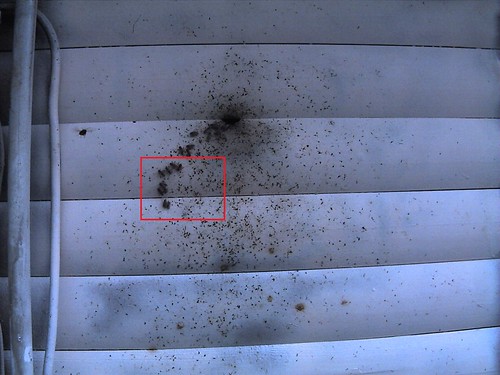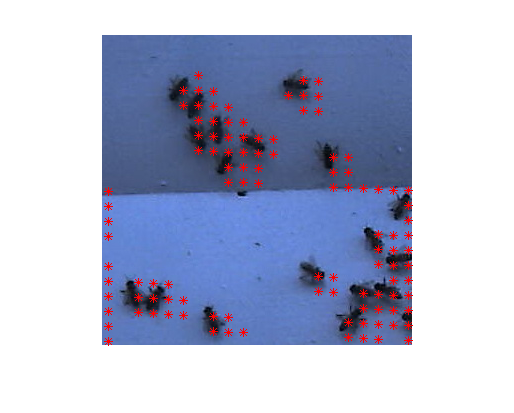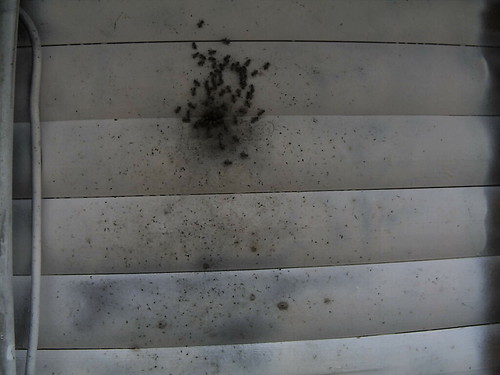Abstract
This project is going to implement a object recognition module for a on field environmental observing system. Specifically, tracking bee population and activities by on field camera data. I have taken CSE166 in Fall 2009 as the qualification for CSE 190a project.
1. Introduction
This project is going to join the on going research of a ecological image database system in California Institute for Telecommunications and Information Technology(Calit2) and Taiwan Forestry Research Institution(TFRI). This project is going to use a computer vision approach to count the number of bees in the image database which were taken from the Shanping Workstation in Taiwan. Furthermore, this project is attempt to make the program as portable as possible so that a on-field camera is able to determine whether or not sending more image or video to the workstation.
2. Milestones
2.1. Week 1
Installation necessary tools (find a possible way of connecting the interfaces such as Java and Matlab) compare the test result of different libaries.
2.2. Week 2
Build a minimum algorithm for bee recognition. Build a practice set of images, identify possible problems for the image set.
2.3. Week 3-4
Build a basic program to distinguish background and the bees. The program should be able to handle different ligtings aross different time of a day as well.
2.4. Week 5
Add wasp recognition to the prorgam in order to triger the wasp attack event.
2.5. Week 6-8
Add aglinment across different images, so that the change of camera viewpoint. The program should be able to handle external events (such as birds or other objects in the scene) and fatal errors (completely dark image or camera outrage)
2.6. Week 8-10
Testing and integration phrase. It is expected to run this program on an embeded computer with MIPS processor. CPU and memory usage should be optimized.
3. Problems to be solved
3.1. How to distinguish background and the objects of interest
By observing the images, the good side is backgrounds do not change frequently, but the down side is backgrounds containt a lot of distractions (black dots which look very much alike to a bee)
3.2. How to handle the cases when bees group together and stack on top of each other
As illustrated in Figure 1. when bees are closed to each other.
When a wasp attacks the bees, bees group together around the wasp and vibrate in order to defence their nest. If a wasp can be recognize the program should be able to triger the camera and perform a video capture [3].
3.3. Camera alignment and lighting problems.
It would be much easier to perform the counting task if the program is able to take the background away. However, camera position changes over time because of wind, gravity or any other external force. For anther thing, lighting of the scene changes over time. In order to ignore the background, a baseline should be drawn.
3.4. On field camera integration problems
The final report will adress difficulties and problems of integration with a realtime on field camera.


Figure1: Sample image from TFRI
Upper: A sample image from TFRI website taken at Feb 04, 2009 7:02 AM [1] original size 1600*1200 pixels
Lower: Cropped image from the upper image
4. Softwares to build upon
This project is going to be developed in Matlab and Java, and interfaced with the open source middle ware Data Turbine[2], specifically, Ring Buffered Network Bus (RBNB) and/or Realtime Data Viewer (RDV) [4].
5. Datasets
This project will use the images from archiving gallery of Shanping workstation of TFRI [1]. Image resolution is 1600*1200 since September 2008. White painted background since December 2008.
References
[1] Sensor Archiving Gallery of Shanping Workstation http://srb2.tfri.gov.tw/wsn/
[2] Open Source DataTurbine Initiative: Streaming Data Middleware and Applications, Tony Fountain, Sameer Tilak, Jane Rutherford and delegation from Canada, (2008)
[3] Ecological image databases: From the webcam to the researcher, John Porter, Chau-Chin Lin, David E. Smith, Sheng-Shan Lu (2009)
[4] A visualization environment for scientific and engineering data http://code.google.com/p/rdv/










